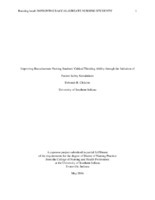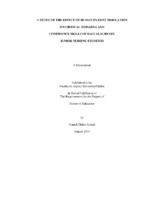Improving baccalaureate nursing students' critical thinking ability through the initiation of patient safety simulations
View File(s)
Visitor Statistics
Visits vs Downloads
Visitors - World Map
Top Visiting Countries
| Country | Visits |
|---|
Top Visiting Cities
| City | Visits |
|---|
Visits (last 6 months)
Downloads (last 6 months)
Popular Works for Chilcote, Deborah R. by View
| Title | Page Views |
|---|
Popular Works for Chilcote, Deborah R. by Download
| Title | Downloads |
|---|
View Citations
Citations
Patient safety is the priority objective within the healthcare system (Harjai & Tiwari, 2009; Robert & Petersen, 2013; Robson, Clark, Pinnock, White, & Baxendale, 2013; Vaismoradi, Salsali, & Marck, 2011). The Institute of Medicine (IOM) has estimated that more than 98,000 people die from medical mistakes every year, with an additional one million patients suffering injures (Fero, Witsberger, Wesmiller, Zullo, & Hoffman, 2008, p. 140). In the hospital setting, registered nurses (RNs) are in close daily contact with patients at the bedside, playing a crucial role in identifying deteriorating patients or non-safe patient situations (Henneman et al., 2010; Vaismoradi et al., 2011). Nurses oversee, coordinate, and provide direct patient care, becoming a barrier between the patient and potential safety hazards in the health care system (Despins, Scott-Crawford, & Rouder, 2010; Frith, Anderson, Tseng, & Fong, 2012; Vaismoradi et al., 2011).
This item has been submitted to the repository as part of a collective effort of the nursing faculty and students of the University of Southern Indiana (USI), College of Nursing and Health Professions. This broad dissemination effort will increase the visibility and impact of the work of the USI nursing program and benefit nurses and the nursing profession on a global level.
| Type | DNP Capstone Project |
| Acquisition | Self-submission |
| Review Type | Peer-review: Single Blind |
| Format | Text-based Document |
| Evidence Level | Cohort |
| Research Approach | Quantitative Research |
| Keywords | Simulation; Critical Thinking; Patient Safety |
| CINAHL Subject(s) | Simulations; Critical Thinking; Critical Thinking--Education |
| MESH Subject(s) | Patient Safety |
| MESH Subject(s) | Patient Safety |
| Grantor | University of Southern Indiana |
| Level | DNP |
| Year | 2016 |
| Name | 20th Annual Research, Evidence-Based Practice and Performance Improvement in Healthcare Conference |
| Host | University of Southern Indiana |
| Location | Evansville, Indiana, USA |
| Date | 2016 |
All rights reserved by the author(s) and/or publisher(s) listed in this item record unless relinquished in whole or part by a rights notation or a Creative Commons License present in this item record.
All permission requests should be directed accordingly and not to the Sigma Repository.
All submitting authors or publishers have affirmed that when using material in their work where they do not own copyright, they have obtained permission of the copyright holder prior to submission and the rights holder has been acknowledged as necessary.
Related items
Showing items related by title, author, creator and subjects.
-
Improving the new graduate and undergraduate student nurses' critical thinking ability through the use of simulation in nursing: A systematic review of literature
Sansom, Amanda L. (2015-10-26)Background: Implementing what is learned in the classroom into clinical practice is an important aspect of nursing. According to Koontz, Mallory, Burns, and Chapman (2010) the clinical environment is one of the most valuable ... -
High-fidelity simulation influences on novice baccalaureate nursing students
Connelley, Barbara (2016-12-22)Current research supports high-fidelity simulation use as a method for educating junior and senior nursing students. The purpose of this study was to examine the relationship that existed between the use of evidence-based ... -
A study of the effect of human patient simulation on critical thinking and confidence skills of baccalaureate junior nursing students
Joseph, Yanick D.This quantitative study sought to evaluate human patient simulation’s (HPS) impact on junior student nurses’ critical thinking and confidence skills. The study investigated the impact of simulation as an adjunct ... -
Enhancing critical thinking disposition and clinical judgment skills in senior BSN students via electronic interactive simulation
Weatherspoon, Deborah L. (2017-01-09)The problem investigated in this study was the lack of empirical evidence available regarding the effectiveness of electronic interactive simulation (EIS) for developing critical thinking disposition and clinical judgment ... -
Effect of implementation of simulation on critical thinking skills in undergraduate baccalaureate nursing students
Knoesel, Joanne M.Human patient simulation (HPS) is a time and cost intensive teaching modality that is used widely in nursing education, and has been implemented with little evidence to support its efficacy (Jeffries & Rizzolo, 2006). ...





